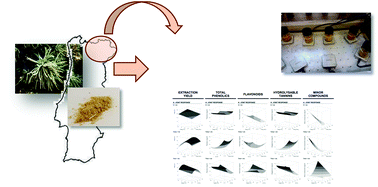Development of a natural preservative obtained from male chestnut flowers: optimization of a heat-assisted extraction technique†
Abstract
The aim of this work was to optimize the conditions for the extraction of phenolic compounds (PC) from male chestnut flowers using heat-assisted extraction in developing extracts rich in PC for potential industrial application as a natural ingredient. The study conditions of time (t), temperature (T), solvent (S, water–ethanol mixtures) and solid-to-liquid ratio (S/L) were optimized. The responses used were obtained from the quantification of the fourteen major individual PC identified by HPLC-DAD-ESI/MS (seven hydrolysable tannins and seven flavonoids). The recovery of hydrolysable tannins was higher than that of flavonoids, with trigalloyl-HHDP-glucoside being the major one. The conditions that maximized the PC content were t = 20.0 ± 37.7 min, T = 25.0 ± 5.7 °C, S = 0.0 ± 8.7% ethanol and S/L = 82.8 g L−1, producing an extract with 86.5 mg PC g−1 of extract. The results highlight the potential of valorising chestnut flower agro-residues as a productive source of PC for the development of bio-based ingredients for food/pharmaceutical/cosmeceutical industrial applications able to compete with synthetic compounds.



 Please wait while we load your content...
Please wait while we load your content...